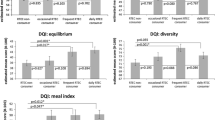Abstract
This observational study aims to evaluate the eating habits of a population of high school students from Emilia Romagna. 492 students aged between 15 and 19 years (265 females and 227 males) were personally interviewed by a dietician regarding their dietary habits, used to assess the macro and micronutrient composition of the diet, the quality of the diet according to the Mediterranean diet quality index (M-DQI) and the total amounts of advanced glycation endproducts (AGEs) ingested daily. The analysis of macronutrients showed a deficit in carbohydrates and an excess in fat, particularly saturated fat, when compared to the recommended daily intake (RDA), particularly evident in males (30.9 ± 7.5 vs. 23.9 ± 6.0, p < 0.001; RDA < 20 g). The analysis of micronutrients depicted a deficit in fibres, particularly in females (15.9 ± 4.0 vs. 18.5 ± 4.5, p < 0.001; RDA = 20–30 g), and in vitamin D (3.04 ± 1.80 μg/day; RDA = 10–15 μg/day). Most of the subjects analysed had M-DQI between medium-poor (280/492, 56.9%) and poor (208/492, 42.3%) while none had a very good score and only three females had a good score. Collectively, males had a worse M-DQI with respect to females. Finally, the total amount of AGEs ingested daily correlated significantly and positively with M-DQI (r = 0.283, p < 0.001) and, accordingly, it was significantly higher in males with respect to females. The evaluation of the M-DQI in this population of high school students indicates a loss of food traditions typical to Mediterranean countries, with a consequent imbalance in macro and micronutrients with respect to the guidelines for healthy nutrition. Consequently, there is an increase in the intake of AGEs that could be one of the causes of the increased incidence of cardiovascular and metabolic complications in Mediterranean countries.
Similar content being viewed by others
References
Knoops KT, de Groot LC, Fidanza F et al (2006) Comparison of three different dietary scores in relation to 10-year mortality in elderly European subject: the HALE project. Eur J Clin Nutr 60:746–755
Harriss LR, English DR, Powles J et al (2007) Dietary patterns and cardiovascular mortality in the Melbourne Collaborative Cohort Study. J Am Diet Assoc 86:221–229
Mitrou PN, Kipnis V, Thiébau AC et al (2007) Mediterranean dietary pattern and prediction of all-cause mortality in a US population: result from the NH-AARP Diet and Health Study. Arch Intern Med 167:2461–2468
Diamanti-Kandarakis E, Piperi C, Alexandraki K et al (2006) Short-term effect of orlistat on dietary glycotoxin and in healthy women with polycystic ovary syndrome. Metabolism 55:494–500
Wautier JL, Guillausseau PJ (2001) Advanced glycation end products, their receptors and diabetic angiopathy. Diabetes Metab 27:535–542
Vlassara H, Cai W, Crandall J et al (2002) Inflammatory mediators are induced by dietary glycotoxin, a major risk factor for diabetic angiopathy. Proc Natl Acad Sci USA 99(24):15596–15601
Michalsen A, Bierhaus A, Nawroth PP et al (2006) Glycotoxins and cellular dysfunction. A new mechanism for understanding the preventive effects of lifestyle modifications. Bundesgesundheitsblatt Gesundheitsforschung Gesundheitsschutz 49:773–779
McCarty MF (2005) The low-AGE content of low-fat vegan diets could benefit diabetics—though concurrent taurine supplementation may be needed to minimize endogenous AGE production. Med Hypotheses 64:394–398
Yamagishi S, Nakamura K, Matsui T et al (2007) Oral administration of AST-120 (Kremezin) is a promising and therapeutic strategy for advanced glycation product (AGE)-related disorders. Med Hypotheses 69:666–668
Lin RY, Choudhury RP, Cai W et al (2003) Dietary glycotoxin promote diabetic atherosclerosis in apolipoprotein E-deficient mice. Atherosclerosis 168:213–220
Gerber M (2006) Qualitative methods to evaluate Mediterranean diet in adults. Public Health Nutr 9:147–1451
Bondia-Pons I, Mayneris-Perxachs J, Serra-Majem L et al (2009) Diet quality of a population sample from Costal north-east Spain evaluated by a Mediterranean adaptation of the diet quality index (DQI). Public Health Nutr 13:12–24
Goldberg T, Cai W, Peppa M et al (2004) Advanced glycoxidation end products in commonly consumed foods. J Am Diet Assoc 104:1287–1291
Baecke JA, Burema J, Frijters JE (1982) A short questionnaire for the measurement of habitual physical activity in epidemiological studies. Am J Clin Nutr 36:936–942
Livelli di Assunzione giornalieri Raccomandati di Nutrienti per la popolazione italiana (L.A.R.N.); Società italiana di revisione umana (revisione 1996)
Istituto Nazionale di Ricerca per gli Alimenti e la Nutrizione (2003) Linee guida per una sana e corretta alimentazione italiana (INRAN)
Baldini M, Pasqui F, Bordoni A et al (2009) Is the Mediterranean lifestyle still a reality? Evaluation of food consumption and energy expenditure in Italian and Spanish university students. Public Health Nutr 12:148–155
Vlassara H, Cai W, Crandall J et al (2002) Inflammatory mediators are induced by dietary glycotoxins, a major risk factor for diabetic angiopathy. Proc Natl Acad Sci USA 99:15596–15601
Sofi F, Cesari F, Abbate R et al (2008) Adherence to Mediterranean diet and health status: meta-analysis. BMJ 337:1344
Kulie T, Groff A, Redmer J, Hounshell J et al (2009) Vitamin D: an evidence-based review. Am Board Fam Med 22:698–706
Regione Emilia-Romagna (2009) Sorveglianza Nutrizionale. Determinanti ed indicatori di rischio obesità nella popolazione infantile. Indagine 2002 e 2006. Collana Contributi 58:118–119
Vieno A, Santinello M, Martini MC (2005) Epidemiology of overweight and obesity among Italian early adolescents: relation with physical activity and sedentary behaviour. Epidemiol Psichiatr Soc 14:100–107
Lazzeri G, Rossi S, Pammolli A et al (2008) Underweight and overweight among children and adolescents in Tuscany (Italy). Prevalence and short-term trends. J Prev Med Hyg 49:13–21
Conflict of interest
None.
Author information
Authors and Affiliations
Corresponding author
About this article
Cite this article
Tarabusi, V., Cavazza, C., Pasqui, F. et al. Quality of diet, screened by the Mediterranean diet quality index and the evaluation of the content of advanced glycation endproducts, in a population of high school students from Emilia Romagna. Mediterr J Nutr Metab 3, 153–157 (2010). https://doi.org/10.1007/s12349-010-0013-z
Received:
Accepted:
Published:
Issue Date:
DOI: https://doi.org/10.1007/s12349-010-0013-z



